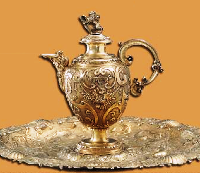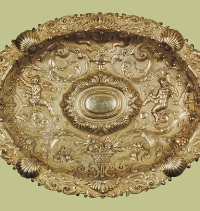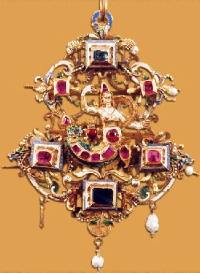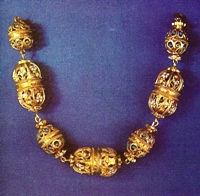At Skrwilno, a locality 80 km east of Toruń, in the Dobrzyń Land, there exist hill fort dating from the 10th or 11th century. During excavations conducted on the site of those early medieval ruins by staff members of the Archeological Department of the District Museum in Toruń, Mrs. Jadwiga Chudziak M. A. uncovered a hoarded treasure dating from the late 16th and the first half of the 17th centuries. The treasure includes objects made from silver and gilded silver, as well as specimens made from gold, i. e. jewellery. The objects constitute a precious collection of decorative handicraft articles of high artistic quality. The find is actually a unique one as far as Poland is concerned.
Objects made from silver
The following specimens made by Toruń silversmiths may be considered as particular by valuable:
A pair of scissors for trimming candle wicks, and four spoons produced by Hans Nickel, a Toruń silversmith and goldsmith of the latter half of the 16th century. Three spoons made by William de Lassensy in the first half of the 17th century. One spoon made by Reinhold Sager in the second quarter of the 17th century. Three spoons by Hans Martelius, a Toruń master craftsman, produced around the middle of the 17th century. A pitcher and a bowl (gilded silver) dated 1617, the works of an Augsburg gilder, a member of Balthaser Gril’s family or an aquaintance of his. Besides the objects mentioned, there is a tankard, four candle's ticks, fourteen buttons belonging in the garment of the contemporary Polish national dress; five of the buttons have rubies set in them, five others have diamonds, and the remaining six are made of gilded silver. There is also a gilded silver belt.
The articles, adorned with armorial bearings and signed with initials, have permitted to identify their owners. The objects bearing the Prawdzic haraldic shield presumably belonged to Stanislaus Piwo, Cupbearer of the Płock Territory about 1549, whereas the articles marked by the Rogala blazon must have probably been the property of John Loka, head of the Borzechowo District, whose daughter, Sophia Magdalena was Stanislaus Piwo’s wife. The letter "Z" recurring on many an object is, in Polish, the first letter of Stanislaus Piwo’s wife’s christian name, Zofia.
Objects made of gold
The Skrwilno find comprises also objects made from gold i. e. jewellery. They are masterpieces of the art, not inferior to the finest European specimens. The jewellery dates from the first half of the 17th century. One of the pieces - the mermaid pendant, i. e. a hanging ornament from about the 1600, is quite outstanding. lt consists of two gold, open work plates parallel to each other, with close space in between. It is richly ornamented with motifs of a geat variety and is set with diamonds; the surfaces are coated with blue, white and green enamel. There are pearls hanging from small ringlets of the pendant. In the middle, a mermaid is holding a hand mirror with a diamond, the mermaid’s tail is set with rubies. Within the reach of her other hand is a heart with a ruby set in it.
One other remarkable object in the collection is a gold chain of the first half of the 17th century. It is made up of circular open work links and eight rosettes connected with one another by means of rings. In between almost each pair of the oval rosettes there are circular links, each of them ornamented with open work. The rosettes are decorated with designs of a variety of motifs, as well as with layers of blue, white, green, and pale purple enamel; and they have rubies and turquoises set in them.
The other objects belonging in the treasure are four bracelets, two of them have clasps laid over with green, blue, or white enamel. The third specimen is coated with black enamel; it bears the letters I.H.S. engraved amid the acanthus leaf motif. The fourth bracelet is provided with a clasp laid over with black enamel with vegetal designs outlined on it. The treasure also contains three chains of the same period, three of which are filigree ones, and the fourth is an incomplete tiny chain, the remainder of a lost whole. Apart from the chains, there are fragments of an object which at the time may well have been capped with a buckle. It seems to be part of the usual fastening of a large cloak with long, rather ornamental sleeves worn by the Polish nobility of the period. The impaired object now consists of eight links - some of them large, others small - in the shape of ellipsoids set horizontally. The links are made of filigree; the larger ones are ornamented with white, blue, green and black enamel; the colour of the enamel applied to the smaller links is blue only.
Mention ought to be also made of four rings, adorned with diamonds and rubies, dating from the first half of the 17th century. One of them is particularly remarkable since it is made up of tvvo Wedding rings combined. The ring is decorated about the escutcheon with a white enamel ornament of leaves and lilies. The escutcheon is set with four gems, i. e. three rubies and one diamond in square settings. Fifty separate pearls of various sizes and of irregular shapes also belong in the Skrwilno treasure.
|
|
The Skrwilno Treasure - Bracelet
The Skrwilno Treasure - Chain, 1600

The Skrwilno Treasure - Lavabo, 1615-1617

The Skrwilno Treasure - Bowl of the Lavabo set to washing hands
The Skrwilno Treasure - Candlesticks and Scissors for trimming candle wicks

The Skrwilno Treasure - Pendant
The Skrwilno Treasure - Filigree Chain, 1st half of the 17th c.

The Skrwilno Treasure - Chain, 1st half of the 17th c.
|